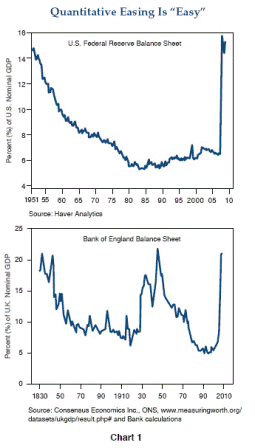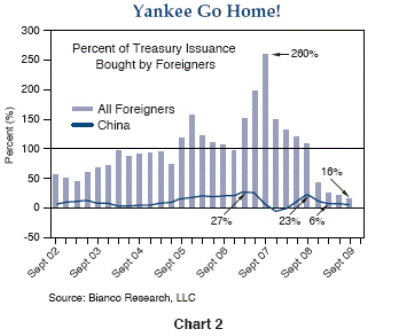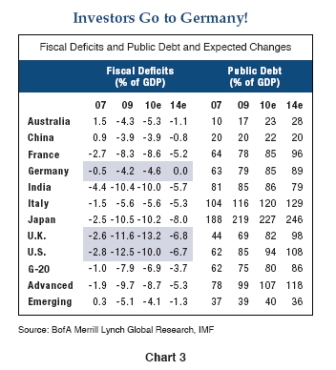The Fed has a dual mandate of full employment and price stability. Both are still moving the wrong way for a hike.
When they move it will likely be based on their forecasts, which remain well on the dovish side.
Karim writes:
Minutes generally more dovish than expected; staff raised forecast, but not by much.Inflation expected to drift lower.
Usual nonsense expressed by some members about effect of QE and deficits on inflation expectations.
STAFF
..the projected pace of real output growth in 2010 and 2011 was expected to exceed that of potential output by only enough to produce a very gradual reduction in economic slack.
…the staff continued to project that core inflation would slow somewhat from its current pace over the next two years. Moreover, the staff expected that headline consumer price inflation would decline to about the same rate as core inflation in 2010 and 2011.
FOMC
..some participants remained concerned about the economy’s ability to generate a self-sustaining recovery without government support. In particular, they noted the risk that improvements in the housing sector might be undercut next year as the Federal Reserve’s purchases of MBS wind down, the homebuyer tax credits expire, and foreclosures and distress sales continue. Though the near-term outlook remains uncertain, participants generally thought the most likely outcome was that economic growth would gradually strengthen over the next two years as financial conditions improved further, leading to more-substantial increases in resource utilization.
The weakness in labor markets continued to be an important concern to meeting participants, who generally expected unemployment to remain elevated for quite some time. The unemployment rate was not the only indicator pointing to substantial slack in labor markets: The employment-to-population ratio had fallen to a 25-year low, and aggregate hours of production workers had dropped more than during the 1981-82 recession. Although the November employment report was considerably better than anticipated, several participants observed that more than one good report would be needed to provide convincing evidence of recovery in the labor market. Participants also noted that the slowing pace of employment declines mainly reflected a diminished pace of layoffs; few firms were hiring. Moreover, the unusually large fraction of those individuals with jobs who were working part time for economic reasons, as well as the uncommonly low level of the average workweek, pointed to only a gradual decline in unemployment as the economic recovery proceeded. Indeed, many business contacts again reported that they would be cautious in their hiring, saying they expected to meet any near-term increase in demand by raising their existing employees’ hours and boosting productivity, thus delaying the need to add employees.
Most participants anticipated that substantial slack in labor and product markets, along with well-anchored inflation expectations, would keep inflation subdued in the near term, although they had differing views as to the relative importance of those two factors. The decelerations in wages and unit labor costs this year, and the accompanying deceleration in marginal costs, were cited as factors putting downward pressure on inflation. Moreover, anecdotal evidence suggested that most firms had little ability to raise their prices in the current economic environment. Some participants noted, however, that rising prices of oil and other commodities, along with increases in import prices, could boost inflation pressures going forward. Overall, many participants viewed the risks to their inflation outlooks as being roughly balanced. Some saw inflation risks as tilted to the downside, reflecting the quite elevated level of economic slack and the possibility that inflation expectations could begin to decline in response to the low level of actual inflation. But others felt that inflation risks were tilted to the upside, particularly in the medium term, because of the possibility that inflation expectations could rise as a result of the public’s concerns about extraordinary monetary policy stimulus and large federal budget deficits. Moreover, a few participants noted that banks might seek, as the economy improves, to reduce their excess reserves quickly and substantially by purchasing securities or by easing credit standards and expanding their lending. A rapid shift, if not offset by Federal Reserve actions, could give excessive impetus to spending and potentially result in expected and actual inflation higher than would be consistent with price stability. To keep inflation expectations anchored, all participants agreed that monetary policy would need to be responsive to any significant improvement or worsening in the economic outlook and that the Federal Reserve would need to continue to clearly communicate its ability and intent to begin withdrawing monetary policy accommodation at the appropriate time and pace.
Although members generally saw little risk that maintaining very low short-term interest rates could raise inflation expectations or create instability in asset markets, they noted that it was important to remain alert to these risks. All agreed that the path of short-term rates going forward would depend on the evolution of the economic outlook.
[top]




